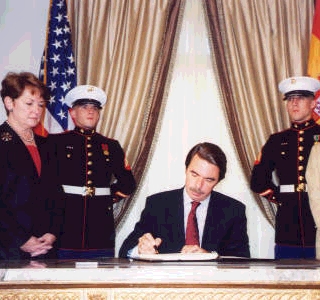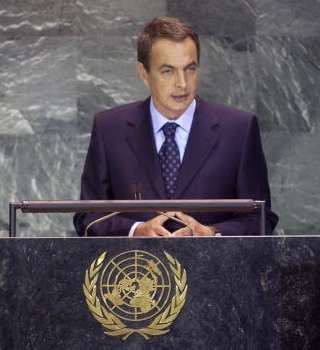May 14, 2006
Intelligence Briefing:
Revolution & Terrorism
Derailing Spain’s 3/11 Investigation
Part 4: The Inside Man
– Continued from Part 3 –
 |
U.S. State Dept. |
Tough on Terrorists: Former Prime Minister José María Aznar improved relations with America, revived Spain’s economy, and damaged the ETA. |
The Communist hatred was based less on Aznar’s actual policies, which represented something of a mix between conservative and liberal agendas, than on what he represented. As a member of the student arm of Francisco Franco’s falangist party, Aznar grew up in the conservative, anti-Communist traditions that had saved his country from disaster decades earlier.1
His political alliances and reputation planting him in the right wing of the People’s Party (and its predecessor, the People’s Alliance), Aznar rose to prominence first as the party’s Secretary General, followed by a variety of positions in the party, in Parliament, as a local Governor, and finally as leader of the People’s Party in 1990. As his party slowly gained on the ruling Spanish Socialist Workers’ Party (PSOE), representing the far left of the nation’s spectrum, even a casual observer could see the handwriting on the wall: Aznar was headed to become Spain’s leader.2
The Communists had no intention of allowing the Socialists to lose power without a fight. On April 19, 1995, the Soviet-controlled Basque ETA swung into action, detonating a powerful bomb on the road as Aznar drove by. The blast would have killed the future president instantly had he not been protected by his armored car. The ETA miscalculation provided Aznar the Divine protection that kept him alive — and swept him into the Prime Minister’s office the following year, toppling the Socialists for the first time in thirteen years.3
Aznar presided over a profound conservative shift in Spanish politics, and soon earned enough popularity to win a second term in 2000 by outright majority vote. During his eight years in power, he unleashed Spanish economic growth and restored its top place among the world’s leading nations by ending various government subsidies, privatizing industries nationalized under the previous Socialist rule, cutting deficit spending, and allowing schools to raise educational standards. The left was furious, mobilizing labor unions and radical student groups in mass protest at every turn.4
More importantly, Aznar reversed Spain’s appeasement of terrorism, cracking down on the Basque ETA. Dozens of ETA leaders were captured and prosecuted; the group’s bank accounts were frozen; its front organization, the Batasuna Party, was declared illegal and its activities suppressed; its newspaper was banned; and ETA prison gangs were disrupted.5
Incredibly, the United States had never proclaimed the ETA a terrorist group. Aznar lobbied hard, persuading the U.S. to include ETA on its list of banned terror organizations in 1999. The new Bush Administration proved reluctant to renew the ban, preferring to allow ETA to become legal once again, until Aznar again changed minds and brought the group back on the official terror list.6
By 2004, the ETA was badly damaged and struggling to maintain its revolution. And Aznar’s People’s Party, with his designated successor as its candidate, was leading far out in front toward an anticipated landslide victory over the Socialists and a third term in power. The Communists were becoming desperate to reverse the political tide.
 |
United Nations |
Red Agent: Spain’s current prime minister, José Luis Rodríguez Zapatero, who engineered the ETA’s rescue. |
His grandfather had been a captain in the terrorist army of the Communist regime that plunged Spain into chaos during the 1930s, and was killed for his crimes. Zapatero himself, and his family, were longtime affiliates of the Spanish Communist Party — the guiding force behind the Red regime of the 1930s and the same organization that, under Soviet guidance, was leading the Basque ETA in its terror campaign. Not until 1979 did Zapatero decide, for purely strategic reasons, to join the PSOE Socialists.7 But Communists always remain agents of the Communist Party, regardless of what other organizations they enter.
Zapatero’s advocacy of more socialism, radical environmentalism, anti-Americanism, and support for the Iraqi Communists made him too extreme for the Spanish voter; his coalition was also caught secretly meeting with ETA representatives, resulting in scandal.8 But the 3/11 bombings of Madrid trains, just three days before the national elections, unexpectedly came to his rescue.
As soon as the ETA realized it would face disaster for the attacks, Zapatero began mobilizing his party and other leftist groups into the streets in blatantly illegal protests. With the objective of covering up ETA’s role in the bombings, Zapatero’s activists loudly insisted, in Orwellian fashion, that the Spanish government was engaged in a cover-up of “Al Qaeda” networks. Zapatero himself was caught publicly lying, hoping to boost the “Al Qaeda” myth by claiming suicide bombers had been found in the 3/11 aftermath.9 The protests worked better than anticipated; not only did Aznar’s government back away from the evidence pointing to ETA, instead searching in vain among foreign Arabs, but frightened Spanish voters switched at the last second to bring Zapatero’s PSOE party into power.
The ETA had been saved, just barely. Two weeks before the 3/11 bombings, ETA members had been caught transporting 1,100 pounds of explosives into the heart of Madrid — and carrying a map highlighting the train routes that would be bombed on March 11!10 If not for the “Al Qaeda” diversion, ETA would have faced doom after 3/11.
Zapatero naturally seized upon his victory to promote homosexual marriage, euthanasia, feminism, and anti-religious propaganda in the schools. Promoting the United Nations, sending U.S. military technology to Marxist ruler Hugo Chavez of Venezuela, improving relations with Communist Cuba, and rehabilitating Communists from Spain’s Red regime of the 1930s all figured prominently on Zapatero’s list of things to do.11 But he also moved quickly to rescue his ETA friends.
With the new prime minister officially promoting their political agenda, the ETA’s soldiers picked up and continued their terror war, hoping to rebuild after Aznar’s crackdown. Waves of new bombings, striking as many as seven cities in a single day and injuring a total of more than 100 bystanders, began by September and continued for the next year and a half.12
But with Spanish and French police moving against the ETA in the wake of 3/11 and renewed intolerance for terrorism, even Zapatero couldn’t cover for the revolutionaries forever. Thus last year he proposed negotiations with ETA — requiring only that the group promise to stop being violent. On March 22 of this year, the exhausted ETA, badly in need of a respite, took up Zapatero’s offer and officially declared a ceasefire.13
The ETA has a long history of declaring truces only to break them again within months, as soon as their logistics have recovered. That happened in 1977, 1989, and 1998, for example.14 But while they stall for time to rebuild, their ally Zapatero will certainly try to advance their goals through negotiations and piecemeal compromise of Spain’s internal security.
Experience has taught the Communists that terror can change the outcome of elections. The action of terrorism is not in the destruction itself, but rather in the public reaction.
References
1. “José María Aznar,” Wikipedia, en.wikipedia.org, retrieved May 12, 2006.
2. Ibid.
3. Ibid.
4. Ibid.
5. “ETA,” Wikipedia, en.wikipedia.org, retrieved May 7, 2006; Wilkinson, T., “Basque separatist group ends four-decade war with Spain,” Los Angeles Times, March 23, 2006, pp. A1, A5.
6. “ETA,” Wikipedia, Op cit.; Wilkinson, T., “Basque separatist group ends four-decade war with Spain,” Op cit.
7. “José Luis Rodríguez Zapatero,” Wikipedia, en.wikipedia.org, retrieved April 1, 2006; Wallace, B., “Zapatero may bring softer sell to Spain,” Los Angeles Times, March 17, 2004, pp. A1, A11.
8. Ibid.
9. Rotella, S. & Wilkinson, T., “Al Qaeda now focus of Spain’s bombing probe,” Los Angeles Times, March 14, 2004, pp. A1, A15; “José Luis Rodríguez Zapatero,” Wikipedia, Op cit.
10. Aznar, J.M., “The truth about 3/11,” Wall Street Journal, March 24, 2004.
11. “José Luis Rodríguez Zapatero,” Wikipedia, Op cit.
12. Wilkinson, T., “Basque separatist group ends four-decade war with Spain,” Op cit.; “ETA,” Wikipedia, Op cit.; Reuters, “Basque rebels hit 7 cities in Spain,” Los Angeles Times, Dec. 7, 2004, p. A6; Mateo-Yanguas, C. & Rotella, S., “Madrid blast blamed on separatists injures 43,” Los Angeles Times, Feb. 10, 2005, p. A3; “Basque leader allegedly tied to ETA is freed,” Los Angeles Times, May 28, 2005, p. A12; “No injuries in bombing near Madrid stadium,” Los Angeles Times, June 26, 2005, p. A4; “Bomb explodes in northwest; 2 held,” Los Angeles Times, July 24, 2005, p. A12.
13. Wilkinson, T., “Basque separatist group ends four-decade war with Spain,” Op cit.
14. Ibid.; Sterling, C., The Terror Network, Holt, Rinehart and Winston, New York, 1981, p. 177.